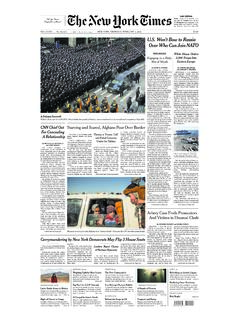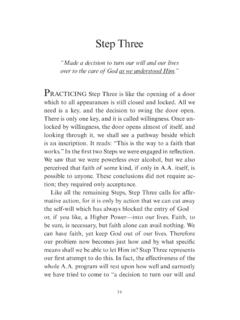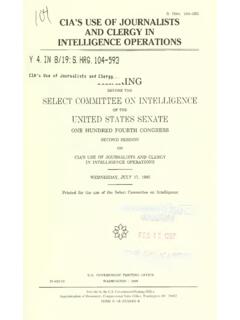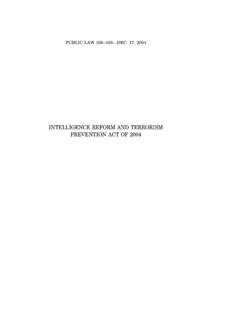Transcription of How to Write an Intelligence Product in the Bottom Line Up ...
1 1 How to Write an Intelligence Product in the Bottom Line Up Front (BLUF) Format This exercise will demonstrate how to Write an Intelligence Product in the BLUF format, using an Intelligence assessment produced by the Department of Justice (DOJ) National Drug Intelligence Center (NDIC) as an example. While you re reading, keep in mind that the point of this exercise is to demonstrate the proper format for an Intelligence piece, not to teach you about drug money laundering or prepaid cards. Why, as Intelligence analysts, are we so concerned about learning how to Write in the BLUF format? Why don t we each Write in the style that suits us best? Like all successful products, Intelligence products must be tailored to meet the needs of their customers: policymakers and commanders.
2 These busy men and women rely on clear, concise, and accurate Intelligence reporting to make daily decisions that affect national security, policies, and the lives of servicemen and -w o m e n . Arranging your Intelligence reporting in the BLUF format helps them efficiently locate and comprehend the information they need. Your project s Title, Executive Summary, and Introduction will be written last. To find out why, see page 7. In this report, the Executive Summary is called Key Judgments. Regardless of its name, this section s purpose to summarize the piece remains the same. 2 Bottom Line Up Front (BLUF): In the BLUF format, the first sentence of each paragraph will sum up all of the information in the paragraph.
3 A good BLUF should cover all of the information in a paragraph, like an umbrella. If the paragraph contains any information that doesn t fall under the BLUF s umbrella, that information should be moved to a more appropriate paragraph or the BLUF should be changed to include the additional information. Following the BLUF, the component sentences in the paragraph should be arranged from most to least important. Background: The section that follows the Introduction should include background information that your audience will need in order to understand the results of your analysis. By presenting this information here, the next section can focus entirely on your analysis without getting bogged down with explanatory details and technical jargon.
4 Because your Product should focus primarily on the results of your analysis rather than the research you conducted to perform it, this section should be concise without sacrificing clarity. This section can be titled in any manner that is appropriate to its contents. Using a BLUF and arranging sentences from most to least important ensures that readers are immediately aware of your Product s most important points and that readers can locate information easily. It is most effective to get right to the point, which is why BLUF is the best way for Intelligence analysts to communicate with policymakers and commanders, who are often too busy to r e a d and carefully digest every word of the Intelligence products they rely upon to make decisions.
5 Summarizing each paragraph at its beginning allows decisionmakers to quickly skim Intelligence products without sacrificing clarity. Because materials that are not in the BLUF format such as academic texts may contain paragraphs with several important ideas located at the beginning, middle, or end, readers who skim these publications may inadvertently miss important information. Moreover, the BLUF format also helps readers locate information. For example, a reader looking for information on types of prepaid cards would, by skimming the BLUFs in the referenced document, immediately understand that the required information is located in the paragraph circled in red (above). 3 Footnotes should be used to convey additional background information, such as definitions, that is not appropriate for inclusion in the background section.
6 Using footnotes to convey this extra information maintains the flow of paragraphs and prevents paragraphs from becoming cluttered with unnecessary concepts. Footnotes also function as an excellent way to communicate to both w e l l-informed and novice audiences in the same document by providing the well-informed reader the opportunity to read straightforward analysis without interruption, while still providing the novice reader with ample background information. Analysis: The section that follows the Background section will contain your analysis, and will generally be the longest part of the paper. This section is often called Substantiation because it substantiates the assertions originally made in the Introduction (see page 7).
7 When communicating your analysis it is imperative that you communicate in a way that is accurate, brief and clear (see page 4). Writing clear and concise products forces analysts to carefully order their thoughts and think critically, and prevents accidental or intentional misrepresentation of the facts, thus improving the final analytical Product . There is no place for the analyst s opinion or editorializing in Intelligence analysis. Everything that you Write must be based on facts that have been analyzed logically and, as much as possible, without biases. This section can be titled in any manner that is appropriate to its contents. 4 Think of a BLUF as an umbrella: All of the information in each paragraph should be covered by the BLUF.
8 BLUF INFORMATION In each paragraph, arrange the details from most to least important. Accuracy, Brevity, and Clarity: In Intelligence writing it s imperative that the language used is as clear, concise, and to-the-point as possible. Carefully chosen language that is accurate, brief, and clear leaves nothing to interpretation, and greatly reduces the likelihood that a decisionmaker will misinterpret your analysis, and, as a result, make a decision that is contrary to interests. As a member of the Intelligence community, national security and policies will be affected by, and the lives of servicemen and -women and civilians may depend on, your analysis and your ability to communicate it to decisionmakers in a way that is nothing less than crystal clear.
9 5 Text Boxes, Charts, and Graphs: Text boxes are commonly used in the body of an Intelligence Product to draw attention to important concepts or highlight anecdotal material. The textbox on page 2 of the referenced assessment is used to highlight important information that must be known for the reader to understand the remainder of the assessment. Charts and graphs should be used in the body of an Intelligence Product to help simplify important concepts. For instance, statistical information that is readily understood when displayed in a graph is often difficult to grasp when presented as text. Lengthy or complicated charts, however, should be located in an appendix. Context: Use this section to provide the reader with the context of your analysis, but be careful not to confuse context with background.
10 The Context section should give your reader a setting for your analysis by providing additional information about the set of circumstances or facts regarding the issue you ve analyzed, while the background section should supply the reader with information that is essential to understanding the issue. Compare the referenced Scope of the Industry section to the Background section of this document; note that a reader who was unfamiliar with the concepts outlined in the Background section would not have the necessary knowledge required to make sense of the Context section. The Context section can be titled in any manner that is appropriate to its contents. 6 Outlook: The Outlook, or conclusion, should neatly sum up the content of the paper.








